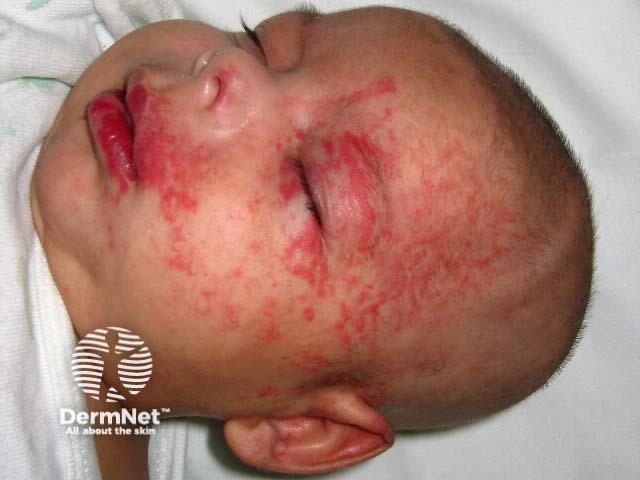Main menu
Common skin conditions

NEWS
Join DermNet PRO
Read more
Quick links
Author: Daniel Jun Yi Wong, Medical Student, University of Melbourne, Australia, 2012.
Introduction Prevalence Signs and complications Significance Diagnosis Causes Investigations Treatment Treatment in infants with propranolol
PHACE syndrome is an association between infantile haemangiomas and malformation of eyes, heart, major arteries, and brain. PHACE was first described by Dr Ilona Freidan in 1996.
The acronym PHACE stands for:
PHACES syndrome is PHACE syndrome plus:

Sternal cleft

PHACES — segmental facial haemangioma

PHACES — segmental haemangioma
PHACE syndrome is rare. PHACE syndrome affects girls nine times more often than boys.[1] One study has suggested that PHACE may be as common, if not more common, than Sturge-Weber syndrome.[2]
Infants with PHACE have:
The specific site or segment affected by a haemangioma can indicate the likely problems in underlying tissues.
Haemangiomas on the face affect four primary segments:
Lumbosacral haemangiomas of the lower back (see LUMBAR) or around the anus and genitals (see PELVIS) have been associated with anomalies of the genitals, spine, anus, and kidneys. These are not classified within the PHACE spectrum.
PHACE(S) syndrome is a clinical diagnosis, i.e., a collection of signs and symptoms or diagnostic criteria are necessary to make a diagnosis of PHACE syndrome. A Consensus Statement on Diagnostic Criteria for PHACE Syndrome published in 2009, proposed major and minor criteria within various organ systems.[3]
Consensus Statement categories |
||
|---|---|---|
Definite PHACE syndrome |
|
|
Possible PHACE syndrome |
|
|
There is no known cause of PHACE syndrome. The relationship of abnormalities found in PHACE syndrome suggests it is a problem in embryonic development at a specific critical time, probably between 3 and 12 weeks gestation when blood vessels are developing.[3]
Infants with large haemangiomas of the face or scalp (>24 cm2) should undergo investigations to establish whether they have PHACE syndrome. These may include:
The management of PHACE syndrome will vary depending on which defects are found in each affected organ system. Care requires a multidisciplinary team and may include a dermatologist, ophthalmologist, haematologist, oncologist, radiologist, neurologist, cardiologist, and otolaryngologist.
Treatment for the haemangioma may involve oral propranolol, systemic steroids, surgery and/or laser therapy.
Severe blood vessel abnormalities in children with PHACE syndrome may restrict the use of propranolol in the treatment of haemangiomas because propranolol may reduce blood pressure (hypotension). Careful evaluation of major blood vessels in the brain and heart should be undertaken if this treatment is considered.